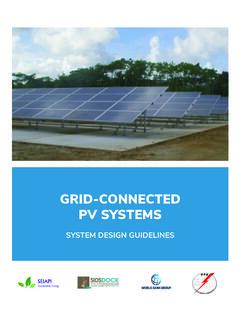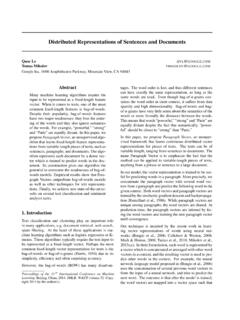Transcription of U.S. Solar Photovoltaic System and Energy Storage Cost ...
1 Solar Photovoltaic System and Energy Storage Cost Benchmark: Q1 2020 David Feldman, Vignesh Ramasamy, Ran Fu, Ashwin Ramdas, Jal Desai, and Robert MargolisJanuary 2021 NREL | 2 Introduction and Key Definitions Overall Model Outputs Market Study and Model Inputs Model Output: Residential PV Model Output: Commercial PV Model Output: Utility-Scale PV Residential PV-Plus- Storage Commercial PV-Plus- Storage Utility-Scale PV-Plus- Storage ConclusionsIntroductionContentsNREL | 3 NREL has been modeling Solar Photovoltaic (PV) System costs since 2009. This year, our report benchmarks costs of PV for residential, commercial, and utility-scale systems, with and without Storage , built in the first quarter of 2020 (Q1 2020).
2 Our benchmarking method includes bottom-up accounting for all necessary System and project-development costs incurred when installing residential, commercial, and utility-scale systems, and it models the Q1 2019 and Q1 2020 costs for such systems, excluding any previous supply agreements or contracts. In general, we attempt to model the typical installation techniques and business operations from an installed-cost perspective, and our benchmarks are national averages. The residential PV-only benchmark and the commercial rooftop PV-only benchmark average costs by inverter type (string inverters, string inverters with direct current [DC] optimizers, and microinverters), weighted by inverter market share.
3 The residential PV-only benchmark is further averaged across small installer and national integrator business models, weighted by market share. All benchmarks include variations accounting for the differences in size, equipment, and operational use (particularly for Storage ) that are currently available in the marketplace. All benchmarks assume nonunionized construction labor; residential and commercial PV systems predominantly use nonunionized labor, and the type of labor required for utility-scale PV systems depends heavily on the development process. All benchmarks assume the use of monofacial monocrystalline silicon PV modules. Benchmarks using cadmium telluride (CdTe)or bifacial modules could result in significantly different results.
4 The data in this annual benchmark report inform the formulation of and track progress toward the Department of Energy (DOE) Solar Energy Technologies Office s (SETO s) Government Performance and Reporting Act (GPRA) cost | 4 The benchmark report builds on several previous publications from NREL and Lawrence Berkeley National Laboratory: Barbose, Galen and Na m Darghouth. 2019. Tracking the Sun: Pricing and Design Trends for Distributed Photovoltaic Systems in the United States 2019 Edition. Berkeley, CA: Lawrence Berkeley National Laboratory. November 2019. Bolinger, Mark, Joachim Seel, and Dana Robson. 2019. Utility-Scale Solar : Empirical Trends in Project Technology, Cost, Performance, and PPA Pricing in the United States: 2019 , CA: Lawrence Berkeley National Laboratory.
5 Fu, Ran, David Feldman, and Robert Margolis. 2018. Solar Photovoltaic System Cost Benchmark:Q1 2018. NREL/TP-6A20-72399. Golden, CO: National Renewable Energy Laboratory. Fu, Ran, Timothy Remo, and Robert Margolis. 2018. 2018 Utility-Scale Photovoltaics-Plus- Energy Storage System Costs Benchmark. NREL/TP-6A20-71714. Golden, CO: National Renewable Energy Laboratory. Ardani, Kristen, Eric O Shaughnessy, Ran Fu, Chris McClurg, Joshua Huneycutt, and Robert Margolis. 2017. Installed Cost Benchmarks and Deployment Barriers for Residential Solar Photovoltaics with Energy Storage : Q1 2016. Golden, CO: National Renewable Energy Laboratory. NREL/TP-7A20-67474. Feldman, David, Galen Barbose, Robert Margolis, Mark Bolinger, Donald Chung, Ran Fu, Joachim Seel, Carolyn Davidson, Na m Darghouth, and Ryan Wiser.
6 2015. Photovoltaic System Pricing Trends, Historical, Recent, and Near-Term Projections. Golden, CO: National Renewable Energy Laboratory. NREL/PR-6A20-64898. | 5 Download the full technical report and the data file: Full report: Data file: are defined at the end of this | 6 Sector CategoryDescriptionSize RangeResidential PVResidential rooftop systems4 kW 7 kWCommercial PVCommercial rooftop systems, ballasted racking100 kW 2 MWUtility-Scale PVGround-mounted systems,fixed-tilt and one-axistracker5 MW 100 MW UnitDescriptionValue2019 dollar (USD) System SizePV systems are quoted in direct current (DC) terms; inverter prices are converted by DC-to-alternating current (AC) ratios.
7 Storage systems are quoted in terms of kilowatt-hours or megawatt-hours (kWh or MWh) of Storage or the number of hours of Storage at peak DefinitionsNREL | 7 Key Changes from Previous Reports Values are inflation-adjusted using the CPI (2019). Thus, historical values from our models are adjusted and presented as real USD instead of nominal USD. Our Q1 2019 and Q1 2020 benchmarks use monocrystalline PV modules, whereas all historical benchmarks used multicrystalline PV modules. This switch reflects the overall trend occurring in the market. In the Q1 2020 residential benchmark analysis, we expand our modeling of customer acquisition, engineering, PII, and overhead.
8 In addition to providing finer cost granularity, we include additional costs borne by many installers that were not captured in previous editions; therefore, our benchmarked soft costs in this report are higher than those in previous reports. For previous editions of this report, we assumed a land acquisition cost of $ Based on Wiser et al. (2020), which stated that most utility-scale PV projects do not own the land on which PV systems are placed, we have reclassified land costs from an up-front capital expenditure (land acquisition) to an operating expenditure (lease payments) for 2019 and 2020. The current versions of our cost models make a few significant changes from the versions used in our Q1 2018 benchmark report (Fu, Feldman, and Margolis 2018).
9 To better distinguish the historical cost trends over time from the changes to our cost models, we also calculate Q1 2019 and Q1 2020 PV benchmarks using the Q1 2018 versions of the residential, commercial, and utility-scale PV models. NREL | 8 Introduction and Key Definitions Overall Model Outputs Market Study and Model Inputs Model Output: Residential PV Model Output: Commercial PV Model Output: Utility-Scale PV Residential PV-Plus- Storage Commercial PV-Plus- Storage Utility-Scale PV-Plus- Storage ConclusionsContentsNREL | are inflation adjusted using the CPI (2019). Thus, historical values from our models are adjusted and presented as real USD instead of nominal categories are aggregated for comparison purposes.
10 Soft Costs Others represent PII; land acquisition; sales tax; and EPC/developer overhead and net profit. current versions of our cost models make a few significant changes from the versions used in our Q1 2018 benchmark report(Fu, Feldman, and Margolis 2018) and incorporate costs that had previously not been benchmarked in as much detail. To better distinguish the historical cost trends from the changes to our cost models, we also calculate Q1 2019 and Q1 2020 PV benchmarks using the Q1 2018 versions of the residential, commercial, and utility-scale PV models. The Additional Costs from Model Updates category represents the difference between modeled results.



















